Film Review: Sunrise: A Song of Two Humans (1927)

In 1920s Hollywood and German cinema industry were rivals, but they also co-operated, mostly through exchange of ideas and, more importantly, talents. Hollywood fared better in such exchange and probably the most spectacular example was provided by Friedrich Wilhelm Murnau, the celebrated director of German Expressionist classics like Nosferatu. His Hollywood debut, 1927 drama Sunrise: A Song of Two Humans, is often considered to be the best silent film ever made.
The film is based on The Excursion to Tilisit, short story by German writer Herman Sudermann. After the opening titles that explain that the theme and characters are universal, plot begins in undefined village where protagonist (played by George O’Brien), simply named “Man” in the credits, lives on a farm with Wife (played by Janet Gaynor) and their little son. Village and its picturesque surroundings are often visited by holidaymakers which include Woman from the City (played by Margaret Livingston) with whom Man has adulterous affair. She nudges him to leave farm and start living with her in bright, exciting city and when he says that he can’t because of wife, she suggests that he drowns her and make it look like a boating accident. He reluctantly agrees to her scheme and brings Wife to the boat, but when he is about to kill her, he can’t. Wife realises that something is wrong and, when they reach shore, she runs to trolley. Man catches trolley and they travel to city where he begs forgiveness. After a while, when they experience all kind of exciting adventures in the city, their love is regenerated. But, upon return, fate would test them again.
Sunrise is actually not the silent film in traditional sense. During the production, Warner Bros. was already experimenting with Vitaphone sound system that would use in The Jazz Singer. Fox Pictures had its own system known as Fox Movietone and employed it to Sunrise, although the added sound included only music by Hugo Riesenfeld and sound effects. Murnau’s film is nevertheless considered the pinnacle of silent cinema and it is mainly to innovative and effective use of cinematography by Charles Strosser and Karl Struss, as well as ingenious technique of using camera and simple optical effects that created impressive images often described as visual poetry. This might be seen in the beginning when Man’s dilemma whether to kill Wife or not is illustrated by conflicting images of Wife and Woman from City around his head. When Man and Wife enter the city, the place looks both realistic and fantastic, just as it would look like the protagonists who have never been to such place. Murnau, invited by studio head William Fox with specific purpose of making Expressionist film in Hollywood, uses the sets instead of actual locations and those sets, combined with optical effects and matte painting, look magical.
Mayer’s script tries to make the story look not only generic, but simple. Protagonist is faced with eternal dilemma countless men had encountered since the beginning of time – whether to reconcile with domesticity and boredom of married life or to seek new, exciting but dangerous and ultimately futile alternative. This theme is explored not only through Murnau’s brilliant direction, but also through clever casting. George O’Brien, who was one of the popular leading man of silent Hollywood, plays Man with ease and natural style which is very rare in over-theatrical world of silent cinema. Janet Gaynor, who was given archaic clothes, funny hat and blonde wig in order to make her plain compared with dark-haired flapper seductress Margaret Livingston, plays her role wonderfully and the very first Oscar for Best Actress she received for this film (together with her performances in 7th Heaven and Street Angel) is quite deserved. Murnau, on the other hand, doesn’t allow his film to be drowned in seriousness and old-fashioned melodrama. He allows brief moments of levity, especially in the city where Man and Wife and their rustic ways provide contrast to “sophisticated” urban life in humorous ways. The result is a film that, despite being silent and despite being melodramatic, is quite capable of appealing to modern audience and leaves impression as something decades ahead of its time.
Sadly, Sunrise, which many described as the peak of silent cinema, also represented something of a swan song. With The Jazz Singer audience suddenly developed taste for characters on screen talking and many of the techniques Murnau and other silent masters proved unusable in the new world of sound, ever-present microphones and bulky soundproof cameras. It would take some time for Hollywood and the rest of world cinema to adapt to new realities. Sunrise, despite universally hailed by critics and even receiving special Oscar for Best Unique and Artistic Picture, proved too “artsy” and silent for general audience. In 1939 Germany director Veit Harlan made sound remake under title The Journey to Tilist starring Kristina Sönderbaum and Philip Dorn.
RATING: 9/10 (+++++)
Blog in Croatian https://draxblog.com
Blog in English https://draxreview.wordpress.com/
Leofinance blog https://leofinance.io/@drax.leo
Unstoppable Domains: https://unstoppabledomains.com/?ref=3fc23fc42c1b417
Hiveonboard: https://hiveonboard.com?ref=drax
Bitcoin Lightning HIVE donations: https://v4v.app/v1/lnurlp/qrcode/drax
Rising Star game: https://www.risingstargame.com?referrer=drax
1Inch: https://1inch.exchange/#/r/0x83823d8CCB74F828148258BB4457642124b1328e
BTC donations: 1EWxiMiP6iiG9rger3NuUSd6HByaxQWafG
ETH donations: 0xB305F144323b99e6f8b1d66f5D7DE78B498C32A7
